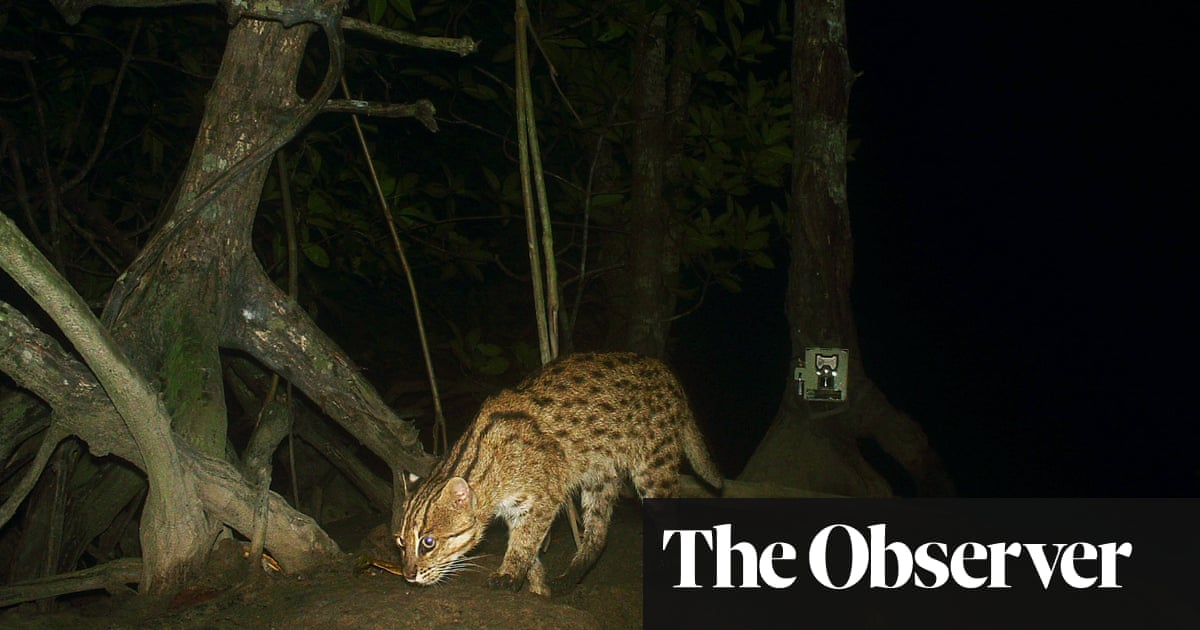
One of the most comprehensive biodiversity surveys ever carried out in a mangrove forest has revealed that an astonishing array of wildlife makes its home in these key, threatened habitats.
Hundreds of species – from bats to birds and fish to insects – were identified during the study of the Peam Krasop sanctuary and the adjacent Koh Kapik Ramsar reserve in Cambodia. Hairy-nosed otters, smooth-coated otters, large-spotted civets, long-tailed macaques and fishing cats, as well a wide range of bat species, were among the residents recorded by the survey, which was funded by the conservation group Fauna & Flora International. The variety of wildlife has staggered biologists.
“We found 700 different species in these mangrove forests but we suspect we have not even scratched the surface,” said Stefanie Rog, the leader the survey team, whose report is published on Sunday. “If we could look at the area in even greater depth we would find 10 times more, I am sure.”
Mangrove forests form narrow strips of tangled, wooded land on coasts in tropical and subtropical latitudes. They are important because they are made up of trees that have adapted to grow in salt or brackish water, which most other plants cannot tolerate. However, over the past few decades, the planet has lost about 40% of its mangroves, which have often been chopped down to make way for beach resorts or agriculture.
Yet mangroves play critically important roles in protecting the land and its inhabitants. Their waters provide nurseries for commercially important fish, for example. “We found young barracudas, snappers and groupers in the waters here,” said Rog. “They are clearly important breeding places for fish and provide local communities with food as well as providing stock for commercial fisheries.”
Mangroves also protect inland areas from tsunamis and storms, trap carbon far more efficiently than other types of woodland, and act as refuges for a stunning array of animals, as the new study revealed through its extensive use of camera traps, nets, fish and insect estimates, and “transect” surveys – studies conducted along a straight line drawn through the landscape.
A key example of the strange species found in the Cambodian mangroves is the fishing cat, Prionailurus viverrinus. Slightly larger than a domestic breed, it is powerfully built, with short limbs and a stocky body, and – unlike most other cats – is happy to swim. Its front toes are partially webbed and its claws protrude, aiding its ability to catch prey, mainly fish and rats, which it stalks while hidden in mangrove roots.
“It’s very rare to see a fishing cat and we have only found out that they are in the forest from the photographs taken by our camera traps,” said Rog.
“Mangroves are places of roots and mud and they are difficult for humans to get into, which is why they provide precious sanctuaries for these vulnerable animals.”
An even rarer animal, the hairy-nosed otter, was also photographed by camera traps in some of the older parts of the mangrove forest. Lutra sumatrana uses hairs around its nose to detect its prey, which is made up of crustaceans, molluscs and other creatures.
after newsletter promotion
It is the rarest otter in Asia and on the verge of extinction – and that is an issue of real concern, said Rog. “A mangrove forest relies on all the interconnected relationships between species and if you start taking away some of those species, then slowly you will lose the functioning of the forest.”
The survey – which was also supported by the Fishing Cat Ecological Enterprise, a conservation group –discovered 74 species of fish living in the forests’ waters, as well as 150 species of birds, of which 15 are listed as near-threatened or endangered on the International Union for Conservation of Nature (IUCN) red list.
Scientists say that mangroves play a key role in preserving ecosystems because they act as two-way barriers between the land and the sea. They slow soil erosion into the ocean and protect coastal communities from flooding and storms.
“But it goes further than that,” added Rog. “Mangrove forests are beautiful, rich, mysterious, and harvest so much life.
“They are so much more than just an ecosystem that provides a carbon-saving service or coastal protection. They are actually beautiful in their own right. For me, there is no better feeling than to be in this unique, mythical forest, knowing there is still so much more to explore – that there is another world waiting for further discovery.”
Read More: World News | Entertainment News | Celeb News
Guardian







